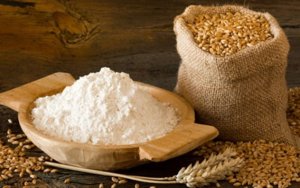 Flour is a fine powder produced by the milling of cereals or other seeds rich in starch and is produced as a raw material for the preparation of many food products, mostly bread.
Flour is a fine powder produced by the milling of cereals or other seeds rich in starch and is produced as a raw material for the preparation of many food products, mostly bread.
There are many types of flours and their distinction is made based on their content in proteins, depending on either the degree and way of milling or on the type of cereal from which they are created.
Every type of cereal affects differently the flavour, the texture and the colour of the final product in which it is used.
The most common types of flours are the following:
- Type M flour (durum): the type M or hard or rustic flour is made from hard wheat. It is strong and rich in gluten and has a distinctive yellowish colour. It is suitable for the preparation of bread, pasta and generally for doughs.
- 70% flour: this flour is produced by selected soft wheats and has the distinctive flourish texture. It contains a minimum quantity of brans, is whiter than the rustic flour and has less content in proteins and gluten. It may be strong or soft and can be used in bakery for the preparation of bread, but also in confectionery for cakes, biscuits, kourabiedes (Greek biscuits) and buns.
- Cornflour: it is a flour made of the endosperm of corn, has a yellowish colour and is rich in vitamin A, iron and calcium. Cornflour is a flour with low content in proteins, its doughs have no elasticity and produce hard but very tasty products. It is indicated for corn bread, breadsticks, Mexican pies, sponge cake and cakes.
- Wholegrain flour: the wholegrain flour contains the whole of the wheat germ and, therefore, is rich in vegetable fibres, vitamins B, E, Ω6, Ω3, proteins and trace elements. It is indicated for brown bread, as well as for a variety of bakery products.
- 55% flour: the flours of this type are also called all-purpose flours, as they are ideal for the preparation of a variety of bakery products, like white bread, cake, crispbread, puff pastries etc.

